Vortex - The Natural Movement
CONSIDERATIONS ON LIGHT, MATTER, GRAVITY AND MAGNETISM
Physics, the science which should be explaining to us how the universe came about and what it consists of, seems to have arrived at the end of a blind alley. Its descriptions of the origin and the workings of our universe get more and more complex, less and less agreed-upon and they are definitely not going to accompany us into the 21st century. We are at the beginning of the space-age. In order to survive in that new age, we need clear and unequivocal descriptions of physical phenomena.
What I see as the most grave shortcoming of establishment physics is its adamant refusal to investigate or at least accept the possibility of a creative life force. There is also a one-sided emphasis on entropic, (explosive, radiative, centrifugal) phenomena in physics and consequently also in current technology, to the almost total exclusion of the constructively ordering, non-entropic phenomena such as brought about by implosion and centripetal or vortex motion.
The descriptive language used by physics is mathematics. It is adequate to describe a number of observed phenomena, but depending on what phenomenon is to be described, physicists conveniently switch mathematics, thereby changing their whole frame of reference. There is no one theory that can adequately describe all the forces known to exist and the search for a unified field theory is running into serious problems.
The trouble is not where physicists commonly look. It seems to be more a question of philosophical or religious outlook. Our view of nature was conditioned first by the great philosophers of ancient Greece and then, for a long time, by the orthodox religions prevalent in current western civilization. Ironically, the physicist who denies the action of a creator, just by this very denial limits the scope of his investigations. He has become "inversely religious", which to an independent scientific investigation is no less limiting than the stand of the dogmatic religionist.
So it might be that progress in our time has become dependent again on philosophy, on that science of thinking, of looking at basics and drawing conclusions that is unencumbered by the specialization so prevalent in the physical sciences.
The following is a speculative description, in simple terms, of the basic workings of the universe.
THE NATURE OF LIGHT
Light sometimes behaves as a wave and sometimes as a stream of particles. The wave theory seems to be confirmed by the observation of interference patterns and the separation of light into colors after passing through a prism, while other phenomena validate the particle (corpuscular) theory. This paradox is so far unresolved and has given rise to a theory proclaiming that light has a dual nature, in other words that light may be both particle and wave at the same time.
Although photons, in reverence to this theory, are generally thought to be "massless particles", there have been research results indicating a rest-mass, although very small, for photons.(1)
WAVES
It would appear that travel over great distances from a substantially point-like source, requires light to have a wave configuration. Particles, such as photons, could hardly be travelling through the immense reaches of space through which we can observe the light of distant stars and galaxies. Imagine all of the immense "ball" of space within the range of visibility of a source of light, such as a star, being actually filled with particles emanated by that light source. The expenditure in terms of mass, even assuming a very small mass for each single photon, would be tremendous. The stars would be exhausted in a relatively short time.
So in order to travel interstellar distances, as light and all other electromagnetic waves evidently travel, they must be waves and not particles. To allow this travel, a medium through which these waves proceed, has been postulated. It has been called various names and has even been "cancelled" by some scientists who argue that since no one has so far been able to detect this medium, it does not exist.
Whatever may be the view of the scientific establishment, space is not empty. The "background" of space might variously be called ether, sea of energy, tachyon field or primordial energy field(3). It is against this background, which so far has eluded our direct observation, that electromagnetic waves propagate.
This space background or primordial energy field has a very high energy density.(4)(5) It has been described as an immense field of pure energy, comparable to a "fluid" that fills all space. This field has so far been very elusive and no direct detection or measurement has been possible. However in November 1980, Japanese physicist Shinichi Seike reported that he had succeeded in proving the presence of this high energy tachyon field in space.(6)
It is this space background that gets excited in wavelike motions by the source or emitter of radiation. Radiation waves propagate in spheric form, in all directions from the source. An analogy in a two-dimensional frame of reference is the surface of a body of water, on which waves propagate in concentric rings. In our space background, we have concentric shells or spheres of wave propagation.
The speed of propagation of these waves is determined by the medium of propagation and is what we call the "speed of light". There is no particular reason for this speed to be either finite or constant. For example, if in the path of an electromagnetic wave we add to the background field a physical medium that allows the passage of light (such as glass or water), the speed of propagation changes for the duration of passage through the medium, but once the additional medium has been passed and the wave travels once more in the background field alone, it will resume its "natural" speed, the speed of light, as conditioned by certain parameters peculiar to that background field.
PHOTONS
When light is directly observed, it is always in the form of photons, that is, tiny particles that will strike a sensitive surface such as our retina or a light-sensitive instrument and determine a certain reaction, called perception or instrument "read".
When we observe light indirectly, we often see interference patterns, which indicate that the light propagated in the form of waves. How is it possible, that one moment light seems to be a wave and the next a stream of particles?
To comprehend this, we must revolutionize our concept of what is mass and what is a particle. In my view particles are nothing more than local irregolarities, local self sustaining "tornadoes" in the background field of space. The properties commonly associated with particles such as mass, inertia and solidity arise out of the movement, the spin, of these tiny tornadoes. A similar view has been put forward by Tewari with his Space Vortex Theory.(7)
One fundamental kind of particle, and probably the buildingstone of all other, more complex particles, is the photon. A photon is postulated to be the result of the collision of an electromagnetic wave of a certain wavelength (light spectrum) with an impenetrable barrier, such as a material object. The impact causes a local disturbance of the background field that can be perceived by the human eye and by our measuring instruments.
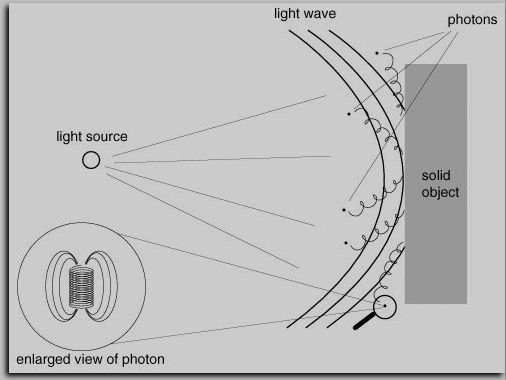
So light, in order to be observed at all, has to necessarily hit a barrier that will transform the wave into a particle, or rather into a little spin-off tornado.
THE FORMATION OF MATTER
Photons have a tendency to combine into aggregates. They will form chains, which in turn will collapse and form "balls" which physicists call subatomic particles. Thus electrons, protons and neutrons as well as the various forms of quarks and leptons, which are observed after smashing atoms in particle accelerators, may be nothing more than variously configured aggregates of photons. What we term to be positive or negative charge is determined by direction of rotation, each subatomic particle being itself configured as a rotating system and thus exhibiting a certain spin.
Just as photons combine to form matter, forming subatomic and eventually atomic particles, the reverse may happen. Particles of matter may become unstable and dissolve, emitting photons or even cause the formation of electromagnetic waves.
A theory of how matter may form through aggregation of photons has been proposed by Helmut Hoegl in 1987.(8)
Oldano, basing himself on the work of Todeschini, has done some detailed work describing the possible geometries of aggregates of the mini-tornadoes or vortexes that make up matter.(9)
It has often been found that the microcosm and the macrocosm are of a remarkable similarity in structure and function. Our view of the atom, in fact, is similar to that of the photon described above. On an even larger level, we may see the same pattern in planetary systems, in galaxies and - why not - in the universe itself. All of these expressions of form as we might call the accumulations of matter are thus nothing else than trapped or frozen energy, "solidified" space background medium.
SPACE AND TIME
If energy is contained in the background medium of space and can be converted into matter through the process of "solidification" of that medium, we must ask ourselves where space and energy come from.
Here we enter religious or at least philosophical territory. Space itself is a transcendental reality. It may contain energy and matter, but it has to exist before these latter two can be introduced. Thus space itself as well as the energy contained in it, first in amorphous form and then as light, are the result of creative action.
It is useless to delude ourselves, ascribing original creation to a nebulous "big bang", because even such a hypothetical big bang would have to start at least from a concentration of matter and an ever so tiny amount of space, which in that case would already have to have existed and so the cat bites its own tail. Without an original act of creation, no universe has so far been known to exist.
This universe happens to have been created with three dimensions and if we assume, for mathematical convenience, that there could be more dimensions this might be true for other universes, but in our present universe, such assumptions must remain what they are - mathematical conventions.
Even time is not a fourth dimension, although we may mathematically represent time in this way. In reality, time is associated with motion of energy and matter through space. It has no independent existence of its own other than as a convention to measure motion. We measure time by how long it takes our planet to revolve around its axis and by the length of a complete orbit of this planet around our sun. In the absence of energy and matter however, space would be without time.
INERTIA AND GRAVITY
According to Einstein, gravitational and inertial acceleration cannot be subjectively distinguished one from the other. It would seem logical therefore to assume that gravity and inertia are two manifestations of one and the same phenomenon.
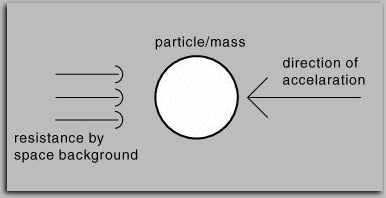
Inertia is postulated to be a resistance of matter to movement against the background of space.
The configuration of matter as an accumulation of a myriad of tiny "tornadoes" (photons)
as well as atoms similarly configured and in constant fluid exchange with the primordial
energy field, lets us presume that there may be a certain resistance of matter against
changing position in space. With increased mass, that resistance or inertia will increase
proportionally.
Once a mass has been accelerated to a certain velocity, it tends to keep moving at the same speed and in the same direction. The conservation of this motion is postulated to be the result of a macroscopic vortex in background space, built up by the motion of the mass, which then tends to maintain that motion.
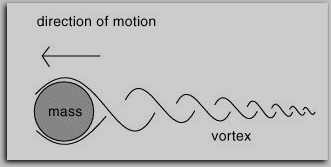
A visual example of this would be an egg held in a stream of tap water. If the egg is held by fine strings, it will create a vortex in the water "downstream" and will be holding its position on top of that vortex. Another example, always using the medium of water, is the ability of trout to stand motionless without visible effort in the most fast flowing stream of water.
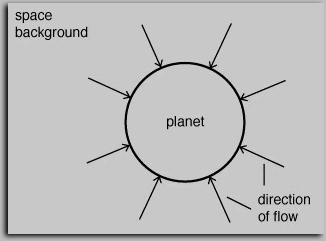
Gravitational "attraction" as experienced between large masses and by us humans on the surface of our planet, is thought to be a pressure phenomenon, rather than an attracting force. It is caused in a similar way as inertia, by a resistance against movement relative to the background of space. There may be an inflow of background field towards large bodies, causing a movement of background field relative to the surface of such large bodies, which is felt as gravitation. This force is stronger near the surface of the mass and diminishes with increasing distance, the inflow becoming gradually slower or "thinned out" as distance increases. The close proximity of the large mass prevents the build-up of a vortex as with inertial motion.
A theory proposed by Nieper sees gravitational effects depending on a partial shielding effect of large masses against the effects of gravitic pressure inherent in space background.(10)
Electromagnetic phenomena may also have an influence on gravitation, and may one day supply the means to engineer gravitation and anti-gravitation. For an advanced treatise on electrogravitation, I refer to a lecture held in 1988 in Hull, Canada by Bearden.(11)
MAGNETISM
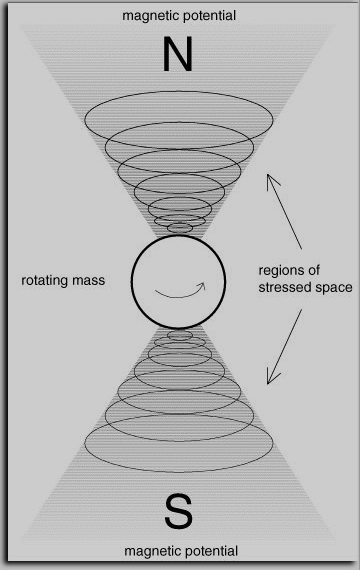
I propose that magnetism is associated with the spin of a particle or mass and that the magnetic field is caused by a dual macroscopic vortex in the background of space, converging on the particle or mass, which polarizes two separate regions of space into a difference of potential.(fig. 1) What we call magnetic field lines are not field lines at all, but simply the intervening space between two poles of different potential, held in place in space by the source of magnetism. One might also call this phenomenon a distortion or stress of space background. The electric current induced in a conductor that cuts "magnetic field lines" is an alleviation of the stress of space background.
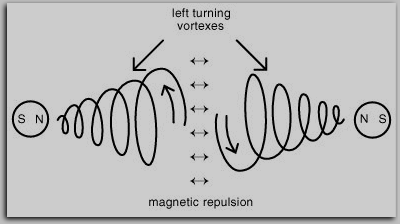
Polarity of magnetic stress is determined by the direction of spin of the vortex. Magnetic poles repel if the associated vortices are of the same direction of spin, they attract if their spins are diverse.
Permanent magnets cause the vortices and consequent stress of space fabric by a permanent alignment of their nuclear spin.
The magnetic field around a conductor in which an electric current flows, is a consequence of the alignment of the spin of the charges moving along that conductor,.
Physicists have been looking, so far without success, for a magnetic "monopole", a magnetic phenomenon that has only a single pole. If magnetism, as postulated here, is a stress phenomenon, then it is clear why the monopole could not be found.
Planetary systems, contrary to what is widely believed, are not held together by gravitation. The orbits of planets are determined by magnetic potentials built up by the central body. The moon rotating around the earth as well as the planets in their orbits around the sun are guided and held by magnetic forces rather than by an equilibrium between gravity and centrifugal force. Such an equilibrium would be inherently unstable. Certainly gravitation and centrifugal force are present and do have an influence, but what determines the exact well defined and layered orbits are magnetic forces.
On a nuclear level, the strong force holding atoms together and determining electron orbits could well be the same magnetic force.
ELECTROMAGNETIC PHENOMENA
In summary, we have electromagnetic waves as a wave-like agitation of background space, proceeding through space in a spherical, shell-like pattern and generating particles at point of impact.
Gravity and inertial forces are caused by linear motion of a mass against the background of space.
Magnetism is caused by a macroscopic vortex motion of the space background itself, polarizing the space background into north and south poles.
These different phenomena are all associated with motion of the space background or primordeal energy field, various types of motion resulting in diverse energetic manifestations.
A THERMODYNAMIC UNIVERSE?
The theorists of the big bang would have us believe that the universe is the result of a super powerful explosion and that it has been expanding ever since. Even though the American COBE satellite has recently detected variations in background radiation, big bang theory is far from confirmed. Its life may have been prolonged by this recent discovery, but the big bang remains in my view an expression of the attitude of current scientific culture that excludes a priori any creative or ordering influence in the making of the universe.
The prime evidence cited for the big bang is the red shift of the light of distant stars and galaxies. This red shift may very well be due to other causes. Moretti (12) and others have made a case for re-interpretation of the red shift.
Another underpinning of the big bang is the second law of thermodynamics, which asserts that a closed system can only evolve in the direction of a state of ever greater entropy. The big bang presupposes that entropy in the universe is on the increase.
First of all, I doubt that the universe can be seen as a closed system, if we consider the existence of a space background of very high energy density. Seike gives this energy density as
E = 8.8 . 108 V/cm. (13)
Wesley has shown that under certain conditions order can be created out of chaos, that is, that the statistical tendency of stellar systems towards greater entropy is reversed by gravitational and solar (stellar) energy playing against a background of free space acting as a giant heat sink.(14)
As recognized by Schauberger and as publicized especially by Baumgartner (15), motion in the form of a vortex is an essentially creative, concentrating, neg-entropic motion. This type of motion is used by nature in the creation of matter, the building up of planetary systems and in the construction and growth of living (biological) systems. We can get an idea of the forces this creative type of motion can harness, observing the power concentrated in a single tornado.
Radiative motion, which we see in the form of explosions, radiation and centrifugal motion on the other hand, is the destructive half of the cycle of nature: Creation and destruction. Radiation is associated with decay and disassociation.
Our present technology and our knowledge in physics is based almost exclusively on the second half of the cycle, the cycle of radiation and decay. We see this in the prevalence of explosion type motors, the extensive use of radiative technology and an almost complete absence of centripetal forms of motion.
This is severely limiting our understanding and our technical possibilities as centripetal or vortex motion results in a violation of the second law of thermodynamics. It has an ordering, a concentrating, a cooling effect, while centrifugal or radiative motion has an entropic, dispersing, heating effect.
With technology unbalanced on one side of the natural cycle, it is no wonder that the use of our machinery has a destructive effect on the environment and on ourselves.
Carnot, basing the laws of thermodynamics on observations of the (steam engine) machinery available at his time, has developed these laws as a description of the actions and reactions of that machinery. He did not know the second half of the cycle of nature, the build-up cycle that uses the vortex, as no technology had been invented to show him.
Unfortunately, the laws of thermodynamics have become gospel in physics, in teaching, in patent offices and so the one-sidedness of our technology has been perpetuated to a complete exclusion of any alternative neg-entropic technology. This even goes so far that patent offices refuse to consider registering inventions that violate the laws of thermodynamics!
CREATION INSTEAD OF BIG BANG
Just as we suffocate all technology based on vortex geometry, we are viewing with suspicion any theory of the creation of the universe, that is not in accordance with thermodynamics. In order to explain the origin of the universe, we thus have to resort to - excuse the term - idiocies, such as the big bang.
There is continuous creation in the universe. I propose that we should seriously look at the cycle of creation and destruction as we see it to exist. This has been described as being a cycle of creation, growth, conservation, decay and destruction.(16) This cycle may be seen as the cycle of an entire universe or any part of that universe. It is also the cycle of life forms or biological organisms. Once the cycle is completed, it starts anew, the products of destruction leading directly to new creation.
Out of chaos, the ordering principle (if we want, the life force) creates by decreasing entropy. This creation goes through a cycle of maturity and eventually into a cycle of decay through an increase of entropy, closing the circle arriving once more at a chaotic state.
We can observe this cycle in any biological organism. It germinates or gets born, then grows up into a mature organism, after which it starts to decay and eventually it dies.
That same mechanism, I believe, is at work in stellar systems, in galaxies and in the universe as such. The difference is only in the time span required for completing the cycle of action. With some observation, we may be able to find out how it works.
Josef Hasslberger
Rome - Italy
May 1992
References:
- Moretti, Angelo. Possibility of Non-Zero Mass in Synchrotron Radiation. In "What Physics for the next century?" pg. 397 - Inediti No. 59, Società Editrice Andromeda, Bologna
- Marinov, Stefan. The interferometric 'coupled mirrors' experiment. In "Eppur si muove", pg. 104 - East West Publishers, Graz
- De Palma, Bruce. Magnetism as a Distortion of a Pre-Existent Primordial Energy Field and the Possibility of Extraction of Electrical Energy Directly from Space. In (the american) "raum&zeit", number 6, 1991 pg. 65
- Gunnufson, Craig. Neuere Neutrinomessungen aus der Sonne unterstuetzen eine neue Theorie. Lecture held at a congress on Gravity Field Energy in Toronto, Oct. 1981. In Nieper, "Revolution in Technik Medizin Gesellschaft", Illmer Verlag, Hannover
- Seike, Shinichi. Lecture held at Energy Symposium in Hannover, November 1980. In Nieper, Revolution in Technik Medizin Gesellschaft.
- Seike, Shinichi. op cit.
- Tewari, Paramahamsa. Detection of Stationary and Dynamic Space Substratum. In "What Physics for the next century?" pg. 184.
- Hoegl, Helmut. Die Energie des Raumes. In (the german) "raum&zeit", number 31, December/January 1987/1988.
- Oldano, Giovanni. Relazione al Congresso "Quale Fisica per il 2000?" In "What Physics for the next Century?", pg. 402.
- Nieper, Hans A. Zur Theorie der Schwerkraftwirkungen. In "Revolution in Technik Medizin Gesellschaft", pg. 46.
- Bearden, T. E. Maxwell's lost Unified Field Theory of Electromagnetics and Gravitation. In "New Energy Technology", pg. 25. Published by The Planetary Association for Clean Energy, Inc. Ottawa/Hull, Canada.
- Moretti, Angelo. A new interpretation of Cosmological Red Shift. In "What Physics for the next Century?", pg. 400.
- Seike, Shinichi. op cit.
- Wesley, J. P. Order out of Chaos. In "What Physics for the next Century?", pg. 345.
- Baumgartner, Walter P. and Jacobson, Rhetta. Vortexian Mechanics. In "Causes Newsletter", September 1988. Also (same authors) Implosion vs. Explosion. In "Causes Newsletter", February 1989.
- Hubbard, L. Ron. Creation and Destruction. In "Scientology 8-8008", pg. 97, published by The Publications Organization World Wide, Edinburgh, Scotland, 1967.







